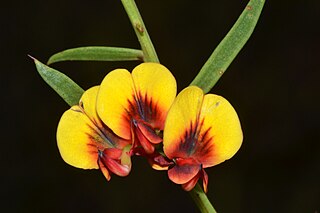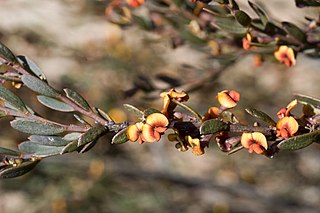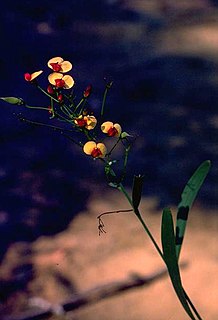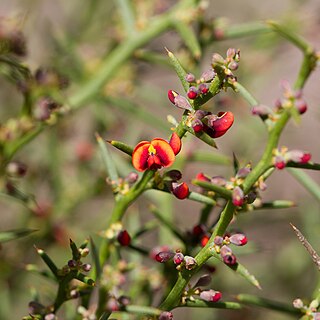
In botany, the petiole is the stalk that attaches the leaf blade to the stem, and is able to twist the leaf to face the sun. This gives a characteristic foliage arrangement to the plant. Outgrowths appearing on each side of the petiole in some species are called stipules. Leaves with a petiole are said to be petiolate, while leaves lacking a petiole are called sessile or apetiolate.

Daviesia, commonly known as bitter-peas, is a genus of about 130 species of flowering plants in the family Fabaceae, and is endemic to Australia. Plants in the genus Daviesia are shrubs or small trees with leaves modified as phyllodes or reduced to scales. The flowers are arranged singly or in groups, usually in leaf axils, the sepals joined at the base with five teeth, the petals usually yellowish with reddish markings and the fruit a pod.

Daviesia cordata, commonly known as bookleaf, is a species of flowering plant in the family Fabaceae and is endemic to the south-west of Western Australia. It is a slender, erect shrub with scattered egg-shaped phyllodes, and yellow-orange and pinkish-purple flowers.

Acacia lineataA.Cunn. ex G.Don, commonly known as streaked wattle or narrow lined-leaved wattle, occurs naturally inland eastern Australia. The genus Acacia is the largest genus of flowering plants in Australia, containing around 1000 species throughout a diverse range of environments from coast to desert.

Daviesia corymbosa, also known as narrow leaf bitter pea, is a species of flowering plant in the family Fabaceae native to the state of New South Wales in eastern Australia. A shrub to 2 m (6.6 ft) high, it grows in sandstone soils in open eucalyptus woodland or heath. It produces showy flowerheads of red and yellow flowers in the spring and early summer.

Daviesia buxifolia, commonly known as box-leaf bitter-pea, is a species of flowering plant in the family Fabaceae and is endemic to south-eastern continental Australia. It is an open shrub with egg-shaped to round phyllodes and yellow or yellowish-orange and maroon-brown flowers.

Daviesia angulata is a species of flowering plant in the family Fabaceae and is endemic to the south-west of Western Australia. It is an erect, spreading shrub with prickly, flattened phyllodes, and yellow flowers with red markings.

Daviesia arenaria, commonly known as sandhill bitter-pea, is a species of flowering plant in the family Fabaceae and is endemic to south-eastern continental Australia. It is usually a hummock-forming shrub with many short, spiny branchlets and heart-shaped to elliptic phyllodes with a sharp point on the end, and orange-pink, maroon and yellow flowers.

Daviesia argillacea is a species of flowering plant in the family Fabaceae and is endemic to the south-west of Western Australia. It is an erect, bushy shrub with erect narrow egg-shaped phyllodes with the narrower end towards the base, and yellow to orange and maroon flowers.

Daviesia articulata is a species of flowering plant in the family Fabaceae and is endemic to the south-west of Western Australia. It is a rigid, low-lying or erect shrub with scattered, tapering, cylindrical and sharply pointed phyllodes, and yellow and red flowers.

Daviesia asperula is a species of flowering plant in the family Fabaceae and is endemic to South Australia. It is a compact or spreading shrub with often crowded, flattened, tapering or curved, sharply pointed phyllodes, and orange-yellow and red flowers.
Daviesia audax is a species of flowering plant in the family Fabaceae and is endemic to the south-west of Western Australia. It is an erect shrub with scattered, erect, thick, rigid, sharply pointed phyllodes, and orange flowers with reddish-brown markings.
Daviesia benthamii is a species of flowering plant in the family Fabaceae and is endemic to the west of Western Australia. It is an erect, bushy shrub with scattered, cylindrical, sharply pointed phyllodes, and yellow-orange and reddish-brown flowers.

Daviesia bursarioides, commonly known as Three Springs Daviesia, is a species of flowering plant in the family Fabaceae and is endemic to a restricted part of the south-west of Western Australia. It is a straggling shrub with widely-spreading, spiny branches, scattered, flattened phyllodes, and yellow, deep pink and maroon flowers.

Daviesia costata is a species of flowering plant in the family Fabaceae and is endemic to the south-west of Western Australia. It is a straggling, multi-stemmed shrub with scattered, erect, linear phyllodes, and yellow and dark red flowers.

Daviesia crassa is a species of flowering plant in the family Fabaceae and is endemic to the south-west of Western Australia. It is a compact, dense, glabrous shrub with densely crowded, thick, club-shaped phyllodes, and uniformly yellow flowers.

Daviesia crenulata is a species of flowering plant in the family Fabaceae and is endemic to the south-west of Western Australia. It is a bushy shrub with broadly egg-shaped phyllodes with a sharply-pointed end and wavy edges, and uniformly yellow-orange and maroon flowers.

Daviesia debilior is a species of flowering plant in the family Fabaceae and is endemic to the south-west of Western Australia. It is a shrub with low-lying stems and many erect branchlets, scattered linear to scale-like phyllodes, and yellow, purplish, orange-pink and dark purplish flowers.

Daviesia devito is a species of flowering plant in the family Fabaceae, endemic to south-eastern continental Australia. It is a dense, prickly shrub with sharply-pointed phyllodes and yellow, red, greenish and maroon flowers. It was previously known as Daviesia benthamii subsp. humilis until that subspecies was split into two new species.

Daviesia epiphyllum, commonly known as staghorn bush, is a species of flowering plant in the family Fabaceae and is endemic to the south-west of Western Australia. It is a rigid, erect, spreading, glabrous shrub with flattened, staghorn-shaped phylloclades with sharply-pointed lobes, and yellowish-red flowers.
![Acacia suaveolens (Sm.) Willd. [as Mimosa suaveolens Sm.] La Billardiere (Labillardiere), J.-J. Houton de, Novae Hollandiae plantarum specimen, vol. 2: p. 87, t. 236 (1804) (Poiteau) Acacia suaveolens 155867.jpg](http://upload.wikimedia.org/wikipedia/commons/thumb/9/9b/Acacia_suaveolens_155867.jpg/330px-Acacia_suaveolens_155867.jpg)





















